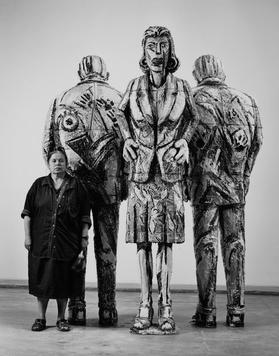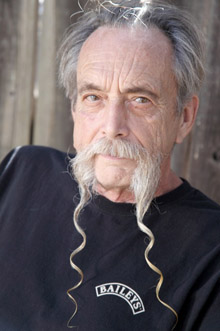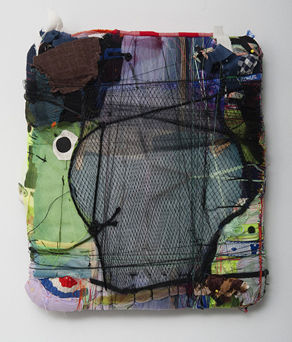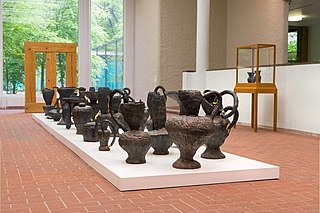Paul Edmund Soldner was an American ceramic artist and educator, noted for his experimentation with the 16th-century Japanese technique called raku, introducing new methods of firing and post firing, which became known as American Raku. He was the founder of the Anderson Ranch Arts Center in 1966.

Peter Voulkos was an American artist of Greek descent. He is known for his abstract expressionist ceramic sculptures, which crossed the traditional divide between ceramic crafts and fine art. He established the ceramics department at the Los Angeles County Art Institute and at UC Berkeley.

The Crocker Art Museum is the oldest art museum in the Western United States, located in Sacramento, California. Founded in 1885, the museum holds one of the premier collections of Californian art. The collection includes American works dating from the Gold Rush to the present, European paintings and master drawings, one of the largest international ceramics collections in the U.S., and collections of Asian, African, and Oceanic art. The Crocker Art Museum has been accredited by the American Alliance of Museums, a high standard for US museums.

Kenneth Price was an American artist who predominantly created ceramic sculpture. He studied at the Chouinard Art Institute and Otis Art Institute in Los Angeles, before receiving his BFA degree from the University of Southern California in 1956. He continued his studies at Chouinard Art Institute in 1957 and received an MFA degree from New York State College of Ceramics at Alfred University in 1959. Kenneth Price studied ceramics with Peter Voulkos at Otis and was awarded a Tamarind Fellowship.

Funk art is an American art movement that was a reaction against the nonobjectivity of abstract expressionism. An anti-establishment movement, Funk art brought figuration back as subject matter in painting again rather than limiting itself to the non-figurative, abstract forms that abstract expressionists such as Jackson Pollock and Mark Rothko were depicting. The movement's name was derived from the jazz musical term "funky", describing the passionate, sensuous, and quirky. During the 1920s, jazz was thought of as very basic, unsophisticated music, and many people believed Funk was an unrefined style of art as well. The term funk also had negative connotations because the word had an association with a foul odor. Throughout the 1960s and 1970s, Funk was a popular art form, mainly in California's Bay Area in the United States. Although discussed as a cohesive movement, Funk artists did not feel as if they belonged to a collective art style or group. This is because while its artists shared the same attitudes and created similar works, they were not necessarily working together.

Robert H. Hudson is an American visual artist. He is known for his funk art assemblage metal sculptures, but he has also worked in painting and printmaking.

Viola Frey was an American artist working in sculpture, painting and drawing, and professor emerita at California College of the Arts. She lived and worked in the San Francisco Bay Area and was renowned for her larger-than-life, colorfully glazed clay sculptures of men and women, which expanded the traditional boundaries of ceramic sculpture.

Clayton George Bailey, was an American artist who worked primarily in the mediums of ceramic and metal sculpture.
Beth Lo in Lafayette, Indiana is an American artist, ceramist and educator. Her parents emigrated from China.

Julia Couzens is a California-based, American artist known for a diverse body of work that embraces unconventional materials and methods and includes drawing, sculpture, installation art, and writing. Critic David Roth identifies as a connecting thread in her evolving work, her "decidedly surrealist-symbolist sensibility, in which eroticism, the grotesque and the gothic mix in equal parts." Her work has been shown internationally and throughout the United States, including solo exhibitions at the Christopher Grimes Gallery and California State University, Stanislaus (2009), in surveys at the University of California, Davis and Sonoma Museum of Visual Art (1999), and group shows at the Crocker Art Museum, P•P•O•W, Orange County Museum of Art, Hammer Museum, and BAMPFA, among others. Her art has been reviewed in the Los Angeles Times, San Francisco Chronicle, Flash Art, New Art Examiner, and Art Practical, among other publications, and collected by institutions including the Crocker Art Museum, Fine Arts Museums of San Francisco, Oakland Museum of California and Butler Institute of American Art, among many. In addition to working as an artist, Couzens has taught at several Southern California universities and writes about contemporary art for The Sacramento Bee and Squarecylinder. She lives and works on Merritt Island in the Sacramento River delta community of Clarksburg and maintains a studio in downtown Los Angeles.
Susan Hale Kemenyffy is an American artist who works primarily in drawing and print media. She is known for the innovative raku art she created in collaboration with her husband Steven Kemenyffy.

Andrew Lord is an English artist based in New York, primarily known for ceramics and drawings. In a 2010 monograph on the occasion of his exhibition at the Milton Keynes Gallery, Dawn Adès commented that his sculpture, informed by painting, ceramics, poetry, the natural world and the city, exemplifies, "The centrality of material things to memory, experience, associations."
Richard Shaw is an American ceramicist and professor known for his trompe-l'œil style. A term often associated with paintings, referring to the illusion that a two-dimensional surface is three-dimensional. In Shaw's work, it refers to his replication of everyday objects in porcelain. He then glazes these components and groups them in unexpected and even jarring combinations. Interested in how objects can reflect a person or identity, Shaw poses questions regarding the relationship between appearances and reality.
Kurt Weiser is an American ceramicist and professor. His work—explorations of the relationship between man and nature through narratives rendered in vivid color—are described as "Eden-like." His work has often taken the form of teapots, vases, and cups, though he has recently begun crafting globes as well. Weiser is currently the Regents Professor at Arizona State University's School of Art.

John Parker Glick was an American ceramicist. Though open to artistic experimentation, Glick was most influenced by the styles and aesthetics of Asian pottery—an inspiration that shows in his use of decorative patterns and glaze choices. His experience working with ceramics led him to publish several articles about the craft. In addition to producing pottery, Glick began making "landscape oriented" wall panels during the latter part of his career. Known as "the people's potter," he is primarily remembered for his contributions to art and the field of ceramics.

Rick Dillingham (1952–1994) was an American ceramic artist, scholar, collector and museum professional best known for his broken pot technique and scholarly publications on Pueblo pottery.
Mary Borgstrom was a Canadian potter, ceramist, and artist who specialized in primitive techniques. She was presented with the "Award of Excellence" by the Canadian Guild of Crafts in Quebec.

Nancy Selvin is an American sculptor, recognized for ceramic works and tableaux that explore the vessel form and balance an interplay of materials, minimal forms, and expressive processes. She emerged in the late 1960s among a "second generation" of Bay Area ceramic artists who followed the California Clay Movement and continued to challenge ceramic traditions involving expression, form and function, and an art-world that placed the medium outside its established hierarchy. Her work has been exhibited at the Los Angeles County Museum of Art (LACMA), Denver Art Museum, Daum Museum of Contemporary Art and Kohler Arts Center, and belongs to the public art collections of LACMA, the Smithsonian Institution, Oakland Museum of California, and Crocker Art Museum, among others. Critic David Roth has written, "Selvin's position in the top rank of ceramic artists has come through a process of rigorous self-examination … what differentiates [her] is that she eschews realism and functionality, indicating a level of intellectual engagement not always found among ceramicists." Writer and curator Jo Lauria described Selvin's tableaux as "elegiac and stylistically unified" works that serve as "forceful essays on the relationship between realism and abstraction, object and subject, decoration and use." Selvin lives and works in the Berkeley, California area.
Jim Melchert was an American visual artist, arts administer, and professor. He known for his ceramics and sculptures. Melchert was part of the Funk art movement.
Anthony 'Tony' Natsoulas is an American sculptor and contemporary artist. Numerous galleries and museums such as the Monterey Museum of Art, La Mirada, Sonoma Valley Museum of Art, and San Jose Museum of Art have exhibited Tony Natsoulas' work in the past; there are several large-scale pieces in public spaces.












